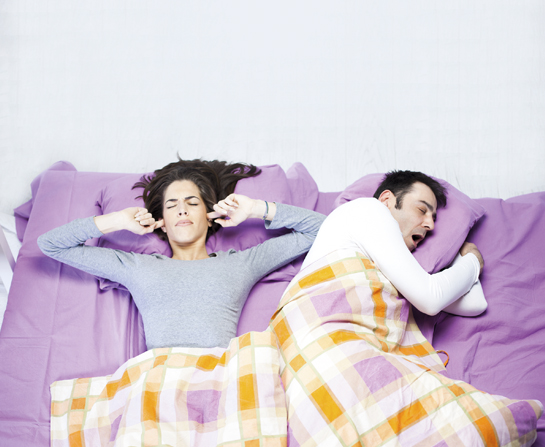ConvOSAtions on Snoring
May 3, 2022 Return


Dr Michelle Clare Mah Lecturer, Faculty of Dentistry, Universiti Teknologi MARA
Snoring describes the loud snorts a person makes while asleep. While you may not be aware that you are a snorer, your bed partner or housemates certainly will!
Snoring is more common than you think. About half of the world population has snored at some point in their life. Men usually snore more than women, with 4-in-10 male snorers out there compared to 3-in-10 female snorers.
It can also be hereditary: if you snore, you could blame your parents as snoring is hereditary in 70% of cases!
What causes the loud snoring sound?
Snoring happens when the tissue at the back of your throat vibrates as air is inhaled through an obstructed airway. This happens when the tissue is too relaxed, when there is an excessive accumulation of fat tissue at the soft palate or even in children with large tonsils. Any obstruction in the nasal airways such as a deviated septum, when you have a cold or a sinus infection may also result in snoring.
Consumption of sleeping pills, antihistamines and alcohol as well as obesity has also been identified as factors that can lead to snoring.
Why should I be worried?
Other than causing sleep deprivation and restless nights for your partner, snoring may be a sign that you might be suffering from obstructive sleep apnoea (OSA).
What is OSA?
OSA is a serious sleep disorder where breathing repeatedly stops and starts during sleep due to obstruction of the airway. This lowers the amount of oxygen levels in the blood and causes the heart to work harder to increase the oxygen saturation. The increased exertion on the heart elevates blood pressure, increasing the risks for heart attack and stroke.
How do I know if I have OSA?
Common signs of OSA include excessive daytime sleepiness, restless sleep and loud or severe snoring. Other less common signs include headaches, trouble concentrating and mood changes such as irritability and anxiety.
Who should I see?
You can see a medical doctor if you experience any of these symptoms and they will examine the nose, mouth, palate, throat and neck for any abnormalities.
If they suspect that you may have OSA, they will refer you to a Sleep Specialist or an Ear, Nose and Throat (ENT) Specialist. You may also be advised to undergo a sleep study either in a laboratory or at home to determine if you suffer from OSA.
How is OSA treated?
Treatment depends on the cause, the severity of the condition and the level of the airway obstruction.
Lifestyle modifications.
Avoiding alcohol, smoking, sedatives and muscle relaxants will help prevent over-relaxation of the tissue in the airway. Weight loss is also recommended for those who are overweight.
Sleeping positions.
Sleeping slightly higher at a 30 degree elevation of the upper body or on the side is recommended as opposed to sleeping on the back.
Non-surgical intervention.
The most common treatment for OSA is the CPAP (Continuous Positive Airway Pressure) machines which pump air into your mouth during sleep to keep the airway open.
Another option is an oral appliance or splint – a mouth guard that is designed to reposition the lower jaw forward during sleep to prevent the tongue from falling back and obstructing the airway.
Surgical intervention.
The aim of surgery is to remove the cause of the airway obstruction or to attempt to widen the airway. This is dependent on the cause of the OSA and the level of the airway obstruction. This may involve soft tissue surgery such as adenotonsillectomy (removal of enlarged adenoids and tonsils), uvulopalatoplasty (reducing part of the tissue at the soft palate or uvula) and palatal stiffening operation (tightening of the tissue at the soft palate) or surgery on the bone such as maxillomandibular advancement where the upper and lower jaws are moved forward to increase the airway space.

References:
Azagra-Calero, E., et al. (2012.) Obstructive sleep apnea syndrome (OSAS). Review of the literature. Medicina oral, patologia oral y cirugia bucal 17 (6): e925–9. doi:10.4317/medoral.17706. PMID 22549673.
Neill A. M., et al. (1997.) Effects of sleep posture on upper airway stability in patients with obstructive sleep apnea. Am. J. Respir. Crit. Care Med. 155 (1): 199–204. doi:10.1164/ajrccm.155.1.9001312. PMID 9001312
Nakano H., et al. (2003.) Effects of body position on snoring in apneic and nonapneic snorers. Sleep 26 (2): 169–72. PMID 12683476.
Loord H., Hultcrantz E. (2007.) Positioner – a method for preventing sleep apnea. Acta Otolaryngol. 127 (8): 861–8. doi:10.1080/00016480601089390. PMID 17762999
Szollosi I., et al. (2006.) Lateral sleeping position reduces severity of central sleep apnea / Cheyne-Stokes respiration. Sleep 29 (8): 1045–51. PMID 16944673.
The American Academy of Head and Neck Surgery. Available at www.entnet.org.
The British Snoring and Sleep Apnoea Association. Available at www.britishsnoring.co.uk
If you like this article, do subscribe here.
